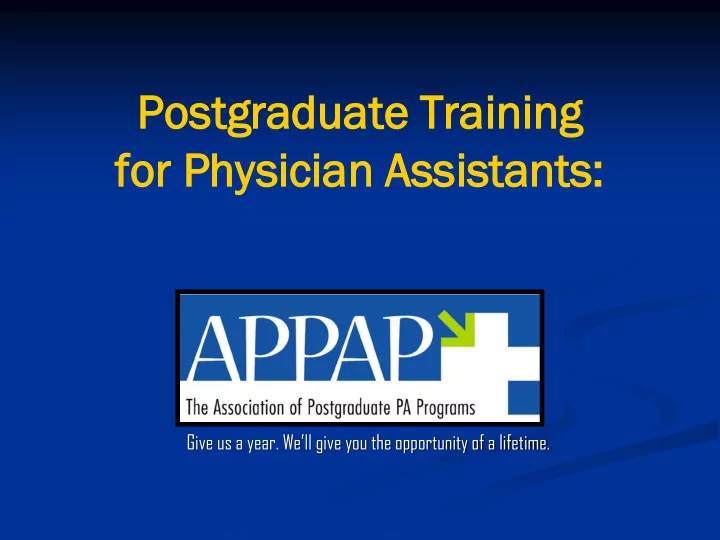

Pos ostgraduate tgraduate Tr Training ining fo for r Phy hysician ician As Assis sistants tants: Give us a year. We’ll give you the opportunity of a lifetime.
Bri rief ef PA PA Hi Histo story ry First PAs to graduate from Duke University in 1967 (50 th anniversary this year) Concept of the PA was created to fill the critical access need in primary care PAs are trained in the general medical model, similar to medical students Shortly after the profession started PAs were called on to enter the specialty arena
When, hen, Where, here, Why hy? Prediction of Surgeon Surplus 1970’s Reduction of surgical residencies Development of first all-PA Residency in Surgery First PA “Resident” Montefiore Medical Center - Bronx, NY 1971 Early PA fellowship/residency programs were primarily in surgery but have evolved to encompass many specialties of surgery and medicine
Pr Progra gramatic matic Tr Troubles oubles Programs quickly developed the reputation of a inexpensive labor workforce. Emphasis was placed on staffing instead of education PA trainees were paid a reduced salary with exceptional work hour expectations There was no oversight to ensure safe and reasonable work hours, compensation, documented educational time, or benefits
APP PPAP AP As Association sociation of Po Postgraduate tgraduate PA PA Pr Programs grams Organization for Postgraduate Programs emerged in 1988 8 Members 2017 60 Programs and new interest every year
Fa Factors ctors Dr Driv iving ing th the e Ne Need ed What's wrong with the way things were? Medical knowledge doubling effect Predicted in 2020 every 73 days Driving the specialization of medicine Global physician deficient: 61,700-94,700 shortage by 2025 Aging population 10,000 people per day turn 65
Fa Factors ctors Dr Driv iving ing th the e Ne Need ed Cost of healthcare Currently non-sustainable: re-define workforce Value based care affecting changes in workflow Increasing Demand for Specialty PAs Primary care focus Complex specialties Technically demanding roles Increase in patient acuity requiring specialty skills
Ty Typical pical Pr Program gram Particular Sub-Specialty 12-Months Certificate (typical) Average $60,000/year ACGME Guidelines Hours Restriction Call Restrictions In-House Hours Restriction Didactic Reading Testing Skill Development Clinical Functioning similar to an Intern Skill Development
Current urrent Pr Progra gram m Di Dive versity rsity
Current urrent Pr Progra gram m Di Dive versity rsity
Current urrent St State ate an and d Fu Future ture Pr Predictions edictions fo for r Po Postgraduat stgraduate e Pr Programs ograms Currently 60 programs are members of APPAP Significant increase in calls for assistance in building programs Anticipate an additional 20 programs in the next 3 years based on inquiries over the past 2 years.
Po Postgraduat stgraduate e Acc ccre reditati ditation on Why hy? Increasing number of clinical postgraduate PA programs Increasing interest in hiring PA graduates of these programs Increasing interest from healthcare systems to build their own programs. Protection of both PA Fellow/Residents as well as employers Renewed AAPA interest in accreditation ( JAAPA May 2016)
Accreditation ccreditation fo for r Po Postgraduat stgraduate e Pr Progra grams ms ARC-PA Same Accreditation Commission for entry level programs Process placed in abeyance in 2014, only 8 programs accredited in 7 years Process extremely laborious and similar to entry level programs ARC-PA currently experiencing a significant increase in the number of applications for entry level programs
Accreditation Process (continued) Currently 218 accredited entry level programs Anticipate 55 new entry level programs by 2018 11 applications for accreditation process received from new programs in 2017 6 new accreditations granted for entry level programs in March 2017 paea.org: accessed 4/15/17
The Postgraduate Revision Work Group Formed at the APPAP business meeting in November 2015 Designed and presented a revised format for postgraduate training to the ARC-PA in March 2016 and answers to subsequent questions in July and September ARC-PA tabled discussion until September 2017
Revisions Goal: a thorough but practical accreditation process Administrative structure Curricular components Evaluation methods Continued reporting and evaluation
CAAHEP Began discussions with CAAHEP through Kathy Megivern in October Decision made to pursue accreditation through CAAHEP at the APPAP business meeting in November Open communication maintained with ARC-PA and AAPA concerning decision
Th Than ank k You ou! Qu Ques estions? tions? Contact Information: ww.appap.org Give us a year. We’ll give you the opportunity of a lifetime.
Recommend
More recommend